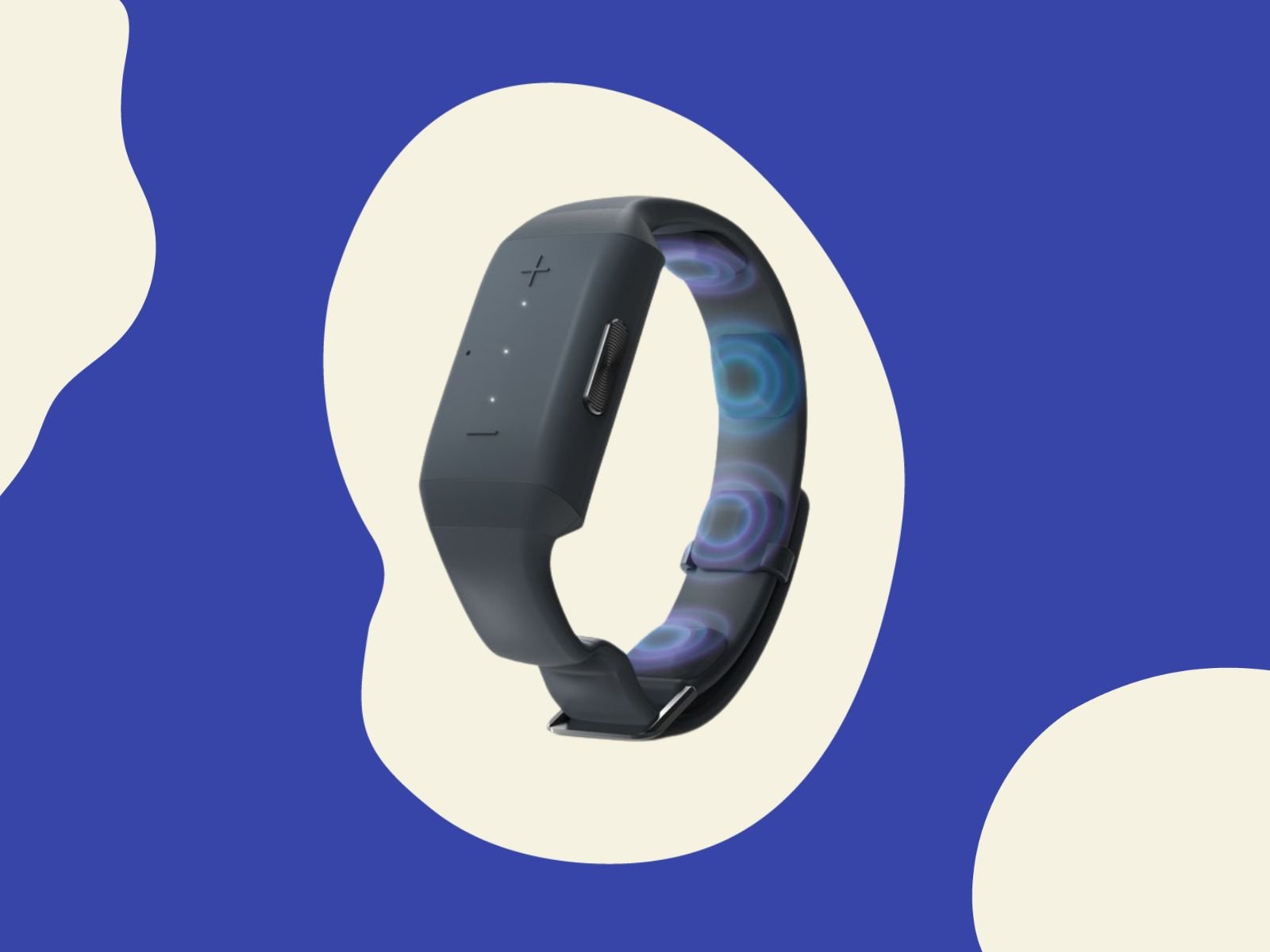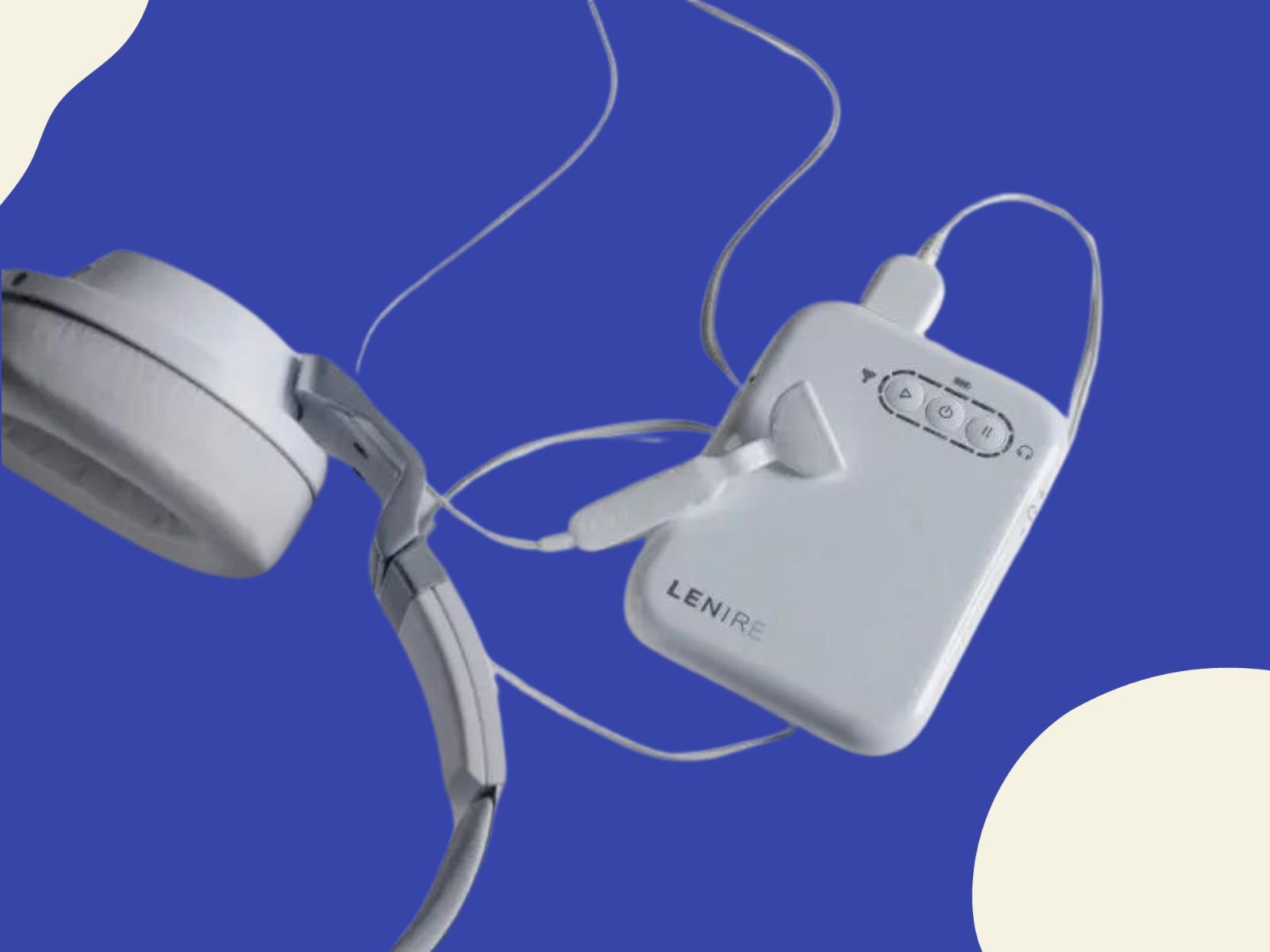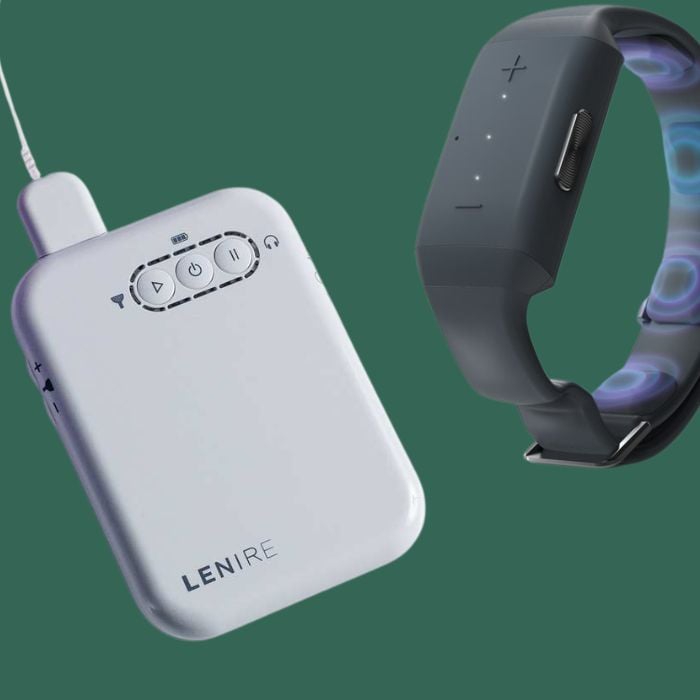Living with tinnitus can be a relentless, frustrating experience. For those who endure the persistent ringing, buzzing, or whooshing sounds in their ears, each day can bring its own unique challenge in finding respite from the auditory phantom of tinnitus. My work as an audiologist has been an ongoing lesson in the multifaceted nature of tinnitus and the need for personalized solutions that can reframe quality of life.
In this post, I'll deep-dive into the realm of emerging technology that aims to provide relief to tinnitus sufferers through bimodal neuromodulation—specifically comparing two cutting-edge devices, Neosensory and Lenire. We'll guide you through what to know about these two different options, similarities and differences, and the pros and cons of each.
Recent Developments in Bimodal Neuromodulation
Bimodal neuromodulation has emerged as a promising strategy for managing tinnitus, particularly for those who have found limited relief with traditional methods such as masking noise or stress management techniques. This approach, which is also utilized in pain management and other medical conditions, operates on the principle of rewiring brain circuitry by providing simultaneous stimulation to multiple sensory pathways.
The goal is to disrupt the maladaptive neural circuits associated with tinnitus, thereby diminishing the perception of the persistent and often distressing tinnitus sounds. By engaging the brain in this unique form of sensory training, bimodal neuromodulation offers a potential path for substantial relief for many who continue to struggle with the complexities of tinnitus.
Understanding Bimodal Stimulation
Bimodal neuromodulation is a sophisticated yet intuitively simple concept at its core. It involves stimulating two distinct sensory pathways or modes simultaneously. The reason behind this dual stimulation is grounded in scientific research, which indicates that activating two different nerves at the same time significantly aids in neuroplasticity—the brain's ability to reorganize itself by forming new neural connections. This process of rewiring old patterns and brain circuits is at the heart of bimodal neuromodulation's potential to effectively lessen the impact of tinnitus.
By carefully orchestrating this dual stimulation, bimodal neuromodulation taps into the brain's inherent adaptability, encouraging it to 'tune out' the disruptive tinnitus noise. This technique is not just about providing temporary relief but aims at a long-term reduction in the perception of tinnitus by fundamentally altering the way the brain processes sound. Thus, it represents hope for many seeking an improvement in their quality of life, enabling them to experience a quieter, more peaceful day.
Two Options: Lenire and Neosensory
For those looking into the realm of bimodal neuromodulation as a viable treatment for tinnitus, it's important to consider the two primary options currently available on the market. The first, Lenire, has received FDA approval, marking it as a significant advancement in the treatment of tinnitus. This prescription product is supported by a network of healthcare professionals, offering personalized treatment plans and ongoing professional support. This level of professional oversight ensures that the individual's treatment is optimally adjusted to their specific needs, leading to effective outcomes in managing the symptoms of tinnitus.
On the other hand, the second option, while not FDA-approved, is endorsed by leading scientists and comes at a more affordable cost. This option provides an accessible alternative for those seeking relief from tinnitus, particularly for individuals who are looking for non-prescription-based interventions.
Both options have their unique advantages, and the choice between them depends on a variety of factors including cost, the desire for professional involvement, and personal preference.

Product Overview: Neosensory
The Neosensory Duo makes use of bimodal stimulation through a wristband device. Worn comfortably around the wrist, this device engages two sensory modalities: auditory and tactile. Currently accessible in the United States, the Neosensory Duo aims to provide an alternative pathway to relief for those burdened by bothersome tinnitus.
How does it work?
The protocol involves a two-month wristband wear schedule, during which users employ a dedicated app to initiate a sequence of tones that vary in pitch. These sounds are delivered both audibly through headphones and physically through tactile vibrations on the skin. Each frequency stimulates a different part of the wristband and creates different vibrational patterns. This dual-channel stimulation is designed to engage the brain’s neuroplastic capabilities, fostering a new understanding of the tinnitus sounds. The limbic system, primarily responsible for processing emotions and behavior, reacts mainly at a subconscious level, making the habituation process to tinnitus sounds variable for each individual.
The Neosensory Duo's approach is distinctly passive, subtly training the subconscious parts of the brain to differentiate between internal tinnitus sounds and external noises. This differentiation is made possible through microphones on the wristband that convert external sounds to vibrations almost instantaneously, allowing the brain to align auditory tones with tactile stimulation. Through this process, the device aims to bridge the perceptual gap, offering a significant step towards mitigating the effects of tinnitus and enhancing the individual's overall quality of life. To sum up, the mechanism of Neosensory is to help the brain decipher between internal and external sounds, which can change the relationship to one's tinnitus on a subconscious level.
Neosensory can also be used in a 'hearing loss' mode or 'environmental awareness' mode in addition to tinnitus support. For example, individuals with severe or profound hearing loss may use the device to help with environmental awareness and safety purposes.
User Experience and Outcomes
We'll start with the most obvious aspect, the look and feel of the wristband. For most people, the wristband, made from hypoallergenic silicone, is comfortable to wear and resembles a larger wristwatch. However, folks with small wrists may find it a bit bulky to wear.
Beyond its physical appearance, the user experience of engaging with the Neosensory Duo is often reported as intuitive and user-friendly. Patients navigating through the dedicated app find it relatively easy to adjust settings and follow the guided sound therapy sessions. Feedback from users regarding the outcomes varies; many describe a noticeable decrease in the intrusiveness of tinnitus over the course of the therapy, with some experiencing a significant reduction in their tinnitus perception. This change is not instantaneous but generally observed towards the end of the prescribed two-month wristband wear schedule.
Overall
Users of Neosensory report a range of experiences. For some, it's a profound shift in their perception of tinnitus, with the noise seemingly fading further into the background; for others, it's a more subtle yet consistent nudge towards greater calm and focus.

Product Overview: Lenire
The Lenire device is created by a company called Neuromod based in Ireland which recently received FDA approval for tinnitus treatment in the United States. It uses simultaneous bimodal neuromodulation by the trigeminal nerve (tongue stimulation) and auditory pathways. The Lenire device comes with a tongue device and a pair of headphones to accomplish this dual stimulation.
If you're wondering why stimulate both the ears and the tongue, the answer is borne out in the research. Tongue stimulation is non-invasive and allows for significant neural stimulation, thanks to the number of nerve fibers concentrated into a small surface area on the tongue.
Read more about Lenire here.
How It Works
The protocol recommends that you wear it for a total of one hour a day, with a half hour in the morning and a half hour in the evening. Users are recommended to relax during device usage for maximum effect. This way neuroplasticity is combined with relaxation, which can help lessen the tinnitus perception. The initial training program lasts six weeks, and is followed up by audiologist consultation in order to review progress and determine future treatment. Typically, Lenire is used for less than two months.
The Lenire protocol is a structured program that gradually introduces customizable sound therapy (i.e., to the user's hearing loss) alongside tongue stimulation. The goal is to habituate the brain to the tinnitus signal and decrease its perceptual prominence over time.
User Experience and Outcomes
The first clinical trial of Lenire had over 300 participants, and while there’s some challenges with developing a pure double-blind gold-standard study involving tongue stimulation, the trial divided participants into two groups: synchronous stimulation and asynchronous stimulation (the latter entailing stimulation of the tongue and ear at different times or changing the tones via small variations).
The trial resulted in 80% of treatment-compliant participants showing continued improvement one year later, along with 80% saying that they would recommend Lenire to others with tinnitus and 65% saying that they benefited from using the device.
Similarities and Differences
At the core, both Neosensory and Lenire utilize the concept of bimodal neuromodulation for tinnitus relief. However, they diverge in the specifics of how they work and user experience.
Shared Goals and Mechanisms
The shared goal is to disrupt and retrain the neural mechanisms that contribute to tinnitus. Both technologies aim to provide a consistent and regulated stream of sensory input that prompts the brain to adapt and recalibrate away from the distressing perception of tinnitus.
Both the Neosensory and Lenire treatments are intended for short-term use which may potentially result in long-term neuroplastic changes within the brain. This approach is not merely to use these devices indefinitely but to catalyze a permanent shift in the brain's processing of tinnitus sounds through a temporary intervention. By engaging in a defined treatment period, users train their brains to diminish the prominence of tinnitus, aiming for lasting relief beyond the active use of the devices.
Technological and Usage Contrasts
Neosensory's tactile approach is distinct from Lenire's emphasis on both auditory and trigeminal stimulation through the tongue. Lenire offers a low-profile user experience, which can take place at home for two sessions each day, for a structured, intentional use. Whereas Neosensory's treatment regimen happens throughout the day while wearing the wristband and is more passive in nature.
One additional difference between the two is in the care model provided with the technology. Lenire is an FDA-approved device and users will work with an audiologist for customized treatment and follow-up appointments. Neosensory is an OTC option that users will set up and adjust to on their own.
Both devices, however, share a common sentiment of hope, offering an alternative to traditional treatments that, while effective for some, may not provide the desired level of relief for all sufferers.
Cost
When evaluating the Neosensory and Lenire devices, one of the most significant contrasts is the financial investment required. Neosensory presents a trial model (with option for purchase after the intial two months) at approximately $249 per month for the first two months, offering a more accessible entry point for individuals seeking relief from tinnitus. This model allows users to assess the efficacy of the device in their personal battle against tinnitus without a long-term financial commitment if they choose not to continue after two months while also allowing those who find benefit to purchase the device for longer term use.
On the other hand, Lenire requires a one-time investment ranging from $3000 to $4000. This upfront cost is prohibitive for some patients. Additionally, it is essential to note that Lenire does not offer a return option, thereby making it a significant financial decision that requires careful consideration. Understanding these financial aspects is crucial as it not only affects accessibility but also influences the decision-making process for individuals seeking tinnitus relief.
Pros and Cons
To make an informed decision, it's critical to examine the potential benefits and drawbacks of these devices.
Neosensory's Advantages and Limitations
Advantages:
- Accessibility: With a subscription-based model, Neosensory is more accessible for those unsure about making a large upfront investment.
- Flexibility: The wearable nature of the device allows for continuous, passive treatment throughout the day, integrating seamlessly into daily routines.
- Innovative Approach: Focusing on tactile stimulation offers a unique treatment path different from traditional auditory-based therapies, as well as the option for multiple use cases (e.g., tinnitus, hearing loss, or environmental awareness modes).
- Trial Period: Offers users the opportunity to test the device's effectiveness for their specific condition with less financial investment if they choose to discontinue after the initial two months.
Limitations:
- Passive Treatment: While convenient, the passive nature of the therapy may not be as engaging or focused as treatments requiring active participation.
- Outcome Variability: The effectiveness can vary widely among individuals, with some users reporting significant benefits and others noticing minimal change.
Lenire's Strong Points and Challenges
Strong Points:
- Comprehensive Approach: Lenire combines auditory and trigeminal nerve stimulation, offering a strong somatosensory and auditory approach to tinnitus relief.
- Structured Treatment: The device provides a clear, daily regimen, allowing for systematic use and potentially better outcomes due to consistency.
- High User Satisfaction: A significant percentage of users report improvement and satisfaction, indicating its potential effectiveness for many.
Challenges:
- High Initial Cost: The upfront investment is substantial, which may deter individuals from trying the device, especially without a return option.
- Time Commitment: The structured, twice-daily sessions may be difficult for some users to maintain consistently over the required period.
- Limited Immediate Accessibility: The higher purchase cost can delay immediate access for those with budget constraints.
No Trial Period: The absence of a trial period means users must commit financially without knowing if the treatment will be effective for their specific case.
Final Thoughts
Ultimately, the choice between Neosensory and Lenire hinges on an individual’s circumstances, preferences, and lifestyle needs. Both approaches offer innovative, non-traditional pathways toward tinnitus relief, reflecting the remarkable strides in understanding and managing this condition. It’s crucial for individuals to weigh the pros and cons, considering the flexibility, cost, and commitment associated with each option.
Whatever decision you make, know that seeking improvement is a step forward in your journey towards better health and well-being. Always consult with healthcare professionals when considering new treatments, and remember, you are not alone in this quest for relief.






